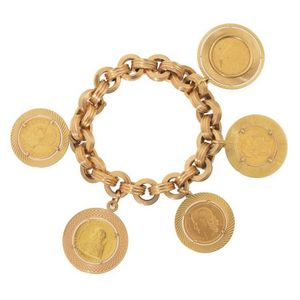Maori ceremonial paddle with intricate carvings and paua eyes
You must be a subscriber, and be logged in to view price and dealer details.
Subscribe Now to view actual auction price for this item
When you subscribe, you have the option of setting the currency in which to display prices to $Au, $US, $NZ or Stg.
- Patination / Patina - In broad terms, patination refers to the exterior surface appearance of the timber, the effect of fading caused by exposure to sunlight and air over the course of a century or more, changing the piece to a soft, mellow colour.
As patina is very difficult to replicate, it is one of the most important guides to determining the age of furniture.
Patina is also the term applied to the bloom or film found on old bronzes due to oxidisation.
This item has been included into following indexes:
Visually similar items

A gold coin bracelet, the hollow belcher link bracelet of reeded design suspended with five framed antique high carat gold coins, mounted in 18ct gold, total length 210 mm.

A 9ct gold full hunter pocket watch, white enamel dial marked N.J.M. Rein Invercargill, with Roman numerals, blued hands, subsidiary seconds keyless wind, push piece at 4 o'clock on a plate movement by Rotherhams London in a guilloche case with vacant cart

Leonie Michaud (France 1873 - ') oil on canvas, portrait of French soldier dated 1922, 45 cm high, mounted in antique gilt wood frame

A pink sapphire and diamond Eternity ring, comprising four pale pink sapphires and three brilliant cut diamonds. 18 carat white gold claw setting. Made by Kozminsky. Ring size L.
